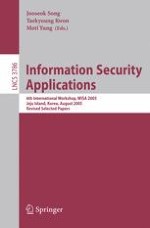2006 | Buch
Information Security Applications
6th International Workshop, WISA 2005, Jeju Island, Korea, August 22-24, 2005, Revised Selected Papers
herausgegeben von: Joo-Seok Song, Taekyoung Kwon, Moti Yung
Verlag: Springer Berlin Heidelberg
Buchreihe : Lecture Notes in Computer Science
